
|
|

I
took over this e-zine when Gail, its originator was unable to continue it. With
Gail's permission, I have added her original Rock's of the Week so that everyone
can find the information readily. Please feel free to visit Gail's web site at http://www.davesrockshop.com. |
|
Labradorite
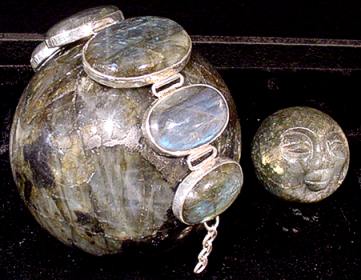
|
|
Scientific:
Labradorite is a sodium rich plagioclase feldspar. It displays a particular type of iridescence on a dark to light smoke gray background. This effect is derived from a mosaic arrangement of platelets of different compositions and minute inclusions of ilmenite, rutile, and magnetite, which cause light diffraction. When light strikes Labradorite from a particular direction, it may display striking rainbow-colored reflections (violet, blue, green, yellow, orange and red) known as "Labradorescence" or "Schiller." It has been described as looking like gasoline laying on water or the delicate wings of a tropical butterfly.
Labradorite's crystal structure is triclinic, however crystals are very rare and are usually golden yellow and may be translucent. Labradorite is usually found as a compact aggregate and is sometimes opaque. It has a vitreous luster and is sensitive to pressure. The yellow striations sometimes fluoresce. |

|
It occurs in metamorphic or igneous rocks in Labrador (Canada), Finland, Madagascar, Australia, Mexico, Norway, what used to be known as the USSR and the USA. The most spectacular rocks come from Finland and Madagascar. Spectrolite is a trade name for Labradorite found in Finland. Lesser rocks come from the USA and Mexico. The main source is Labrador, Canada for which it is named.
It is considered a minor gemstone. It has also been called black moonstone. The value is rather low because it is hard to use and so abundant. Special skill in cutting can bring out the characteristic colors. It's main characteristic is the "Labradorescence" that makes it more valuable. It is cut into beads, gems or flat cabochons for use in jewelry. Sometimes it is carved into shapes or objects of art. It is also used as a flat ornamental material in decorative boxes or for engraving.
|
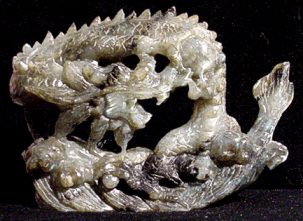
|
Hardness: 6 - 6.5
Chemical Composition: NaAlSi3O8 to
CaAl2Si2O8 (Sodium Calcium
Aluminosilicate) |
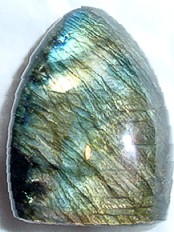
|
History:
During the 18th century, Labradorite was one of the stones frequently used in jewelry in France and England. Pins, broaches, bracelets, etc. were often set with gems, the first letters of which formed a motto or expressed a sentiment. Labradorite was often used as the "L" in mottos like
"Good Luck."
Lore:
Labradorite is one of the gems of winter. The god of the mines picked diamond and Labradorite as the "Gems of Winter," because they both display all colors and tints of the universe. Both gems combine all colors of light in contrast to all other known gems. Labradorite typifies the sun as the gem of light. It is the "temple of the stars", it also symbolizes the moon advancing without constraint. It is the color of ice, as a drop of water from a mountain spring, like icicles sparkling in winter, or like the stars on a cold winter night. Labradorite, like white light, combines all colors. |
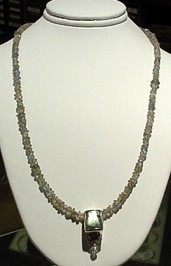
|
|
Myth:
Our planet is said to be divided into two groups of people; those that are drawn to Angelite (a light blue opaque mineral) and those that are drawn to the spectral peacock colors of Labradorite. Those that are drawn to Angelite are said to have roots in
Limoria. Those that are drawn to Labradorite are said to have roots (genetic or past life memories), in Atlantis.
The radiance of Labradorite is like ancient sunlight. It is said to have been preserved from the time when the earth was united with the sun. In people from Atlantis, it is said to awaken the sleeping powers of insight, clairvoyance, creativity and knowledge.
From: Crystal Journey by Jane Ann Dow:
"...This deep penetrating stone acts like a mirror to an inner light within us all... Labradorite is a stone that indicates Atlantis past lives, awakening that early memory of soul that is so important at this time. It stirs long dormant memories..." |

|
Metaphysical:
Labradorite is a kind of feldspar employed in magic, ritual and ceremonies. It is said to elevate consciousness and protect ones aura, helping to keep the aura clear, balanced, protected, and free from energy leaks. It is said to enhance psychic ability and can be helpful in psycho-navigation, shape shifting and in communication with the divine spirit.
It unites the personal self with the understanding required to both realize and achieve the destiny of this life, relieving insecurity and apprehension, while enhancing faith and reliance in oneself and the divine. It is said to help one with originality and precision, and can eliminate judgment from ones contemplative patterns. |
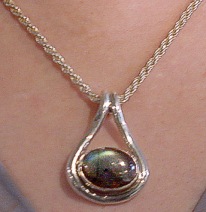
|
|
It can reflect and facilitate transformations which are beneficial to one's existence on this plane. It also enhances patience and an inner knowing of "the right time".
Labradorite is said to energize the body and enhance productivity. It can help us to work productively for long periods without tiring. It stimulates us to exercise and to dance. Labradorite balances and reenergizes those that have been overworking or over scheduling. This stone has inspired everyone here to sing and dance to the song "Shout" from Animal House. |
|










